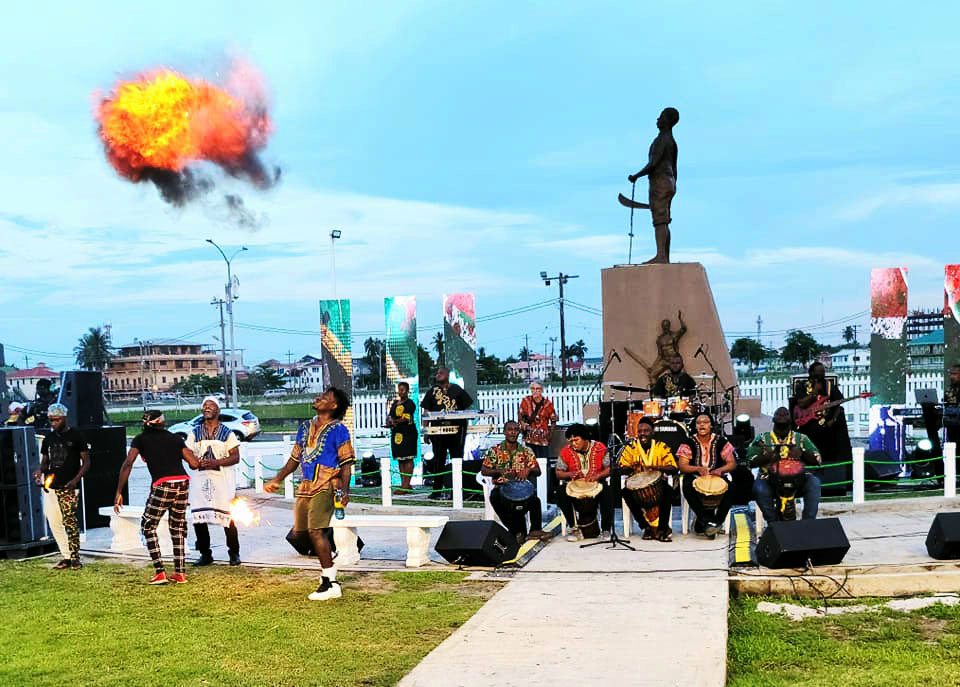 On Friday, the Ministry of Culture, Youth and Sport was to have hosted “The 1823 Bicentennial Cultural Festival and Concert” on the grounds around the 1823 monument on the Kitty seawall. This was to be followed yesterday by an expansive series of continuous performances of African folklore items stretching from mid-afternoon until well into the night at Lamaha Promenade, a section of the recently developed old railway embankment adjacent to Lamaha Street in Georgetown.
On Friday, the Ministry of Culture, Youth and Sport was to have hosted “The 1823 Bicentennial Cultural Festival and Concert” on the grounds around the 1823 monument on the Kitty seawall. This was to be followed yesterday by an expansive series of continuous performances of African folklore items stretching from mid-afternoon until well into the night at Lamaha Promenade, a section of the recently developed old railway embankment adjacent to Lamaha Street in Georgetown.
The August 18, 1823 rebellion on the East Coast Demerara is cited by historians as being largely responsible for the official declaration of the abolition of slavery. The anniversary concert was designed to highlight and dramatise the uprising. Yesterday’s event, with its prolonged evening duration and street-side setting, was to have resembled the old soirees that used to be held in Guyana on the eve of Emancipation Day.
Although the performance items were to be quite varied, these events allowed some reflection on form. This largely arises from the venues used for both and the general structure of yesterday’s planned event. Thoughts on form become relevant because so much of Caribbean theatre evolved from traditional enactments during slavery and in the decades after emancipation. Many traditions with African derivation survived, while others faded, but the influence of African-based traditions remained in evidence in Caribbean theatre. Reflection on these traditions make for rewarding study previously approached in these pages; some parts of it are well worth revisiting in this context.
The performance venues are very relevant to these theatrical traditions. The street-side setting references the soiree, a name in Guyana borrowed from the French which means “an evening’s entertainment”. Much like what was to have happened at Lamaha Promenade yesterday, this was a prolonged event which ran through the night, featuring a series of entertainment as well as spiritual items. It was known to have been enacted on village streets, but has faded out in Guyana. The most recent remnants of it were found in Hopetown and Lichfield on the West Coast Berbice in Region Five.
Performance venues are important because of their place in the history and development of Caribbean theatre and the influence they still have on the stage today. Some of these concepts have been articulated by Trinidadian dramatist Rawle Gibbons. In the African tradition, use of space was a factor. There was a concept of sacred space, one example of which was the Palais, because some enactments were spiritual. But generally, space referred to the place where performances took place. Masquerades were/are performed on the street, and there was much street theatre, which also included Carnival in Trinidad and the Eastern Caribbean. In the African masquerade tradition, the masked and costumed performers dancing on the street were seen as gods visiting. They commandeered the street and rendered it out of bounds for the villagers who fled when the masqueraders were approaching. Some dancers carried whips, which they used to strike anyone on the road who got in their way, because ordinary folk could not share the same space as the gods. This was the case in the Kalabari tradition of south east Nigeria. A similar tradition involved the Egungun of the Yoruba in western Nigeria.
In the Caribbean, the masquerade and Jonkunnu performances in past centuries were religious rituals. As the twentieth century advanced, the spiritual factor began to fade out of Jonkunnu, but the fear factor still hung around. Children (and some adults) were afraid of the masked, costumed dancers. In Jamaica, these included the Horse Head, the Cow Head, the Devil and dancers with whips. The Horse Head had snapping jaws and large, sharp teeth, the Cow jumped about and butted with long sharp horns, the Devil had a pitch-fork with sharp prongs. Sensible onlookers kept their distance. In Guyana, the only remnant of this is the mad cow/bull, a masquerader in a bovine-shaped costume who prances about. That fear factor is part of the traditional performance that prevailed long after the disappearance of the religious roots.
Outdoor environments were most prevalent and the streets of the city and village were frequently used stages for performances. Masquerades of various types proliferated around the Caribbean. The road remains the centre of carnival and that is still strong. All performances are on the road on Carnival Monday and the high day Carnival Tuesday. Furthermore, revellers take to the road on J’Ouvert morning assembling behind trucks and dancing at street corners. The tradition involved an abundance of devils, including Djab-Djab, Djab Molassi and others individually or in gangs who roamed around with mud or grease, driving fear into bystanders with the threat of being daubed with mud or grease. There is much less trepidation when fellow mas players throw powder or water on each other. The J’Ouvert tradition also includes Ol Mas, a satirical act performed on the street early Monday morning. It is an act in which groups or individuals with costumes and props provide humour in satirical comments on topical social or political issues. They compete for prizes.
What is of compelling interest is the consistency of the fear factor in street theatre whether it is spiritual or secular, traditional or western. This can be taken further with the devils. There was strong Christian influence exerted upon these African traditions, and this included the introduction of devils into both the Jonkunnu band and carnival. Christian souls may fear devils, not only because they present with murderous pitchforks, but because they represent all manner of moral turpitude, disrepute and damnation.
The prevalence of devils in carnival has received interesting treatment in calypso. Penguin, for instance, in his 1980 song “Look de Devil Dey”, comments on the fear factor, referring to the fear of devils – Djab-Djabs on the street – and relating it to real society.
“… You fraid the devil, you fraid him bad
Well look the devil right in your yard
… Wey the devil dey? Wey the devil dey?
Look the devil dey.”
“Devil mas” might be a play in carnival, but it still scares people. Ironically, the several devils on the streets are a representation of the devil in real Christian society where he is a symbol of evil. He may be found in many places and persons anywhere.
Of course, like so many other traditions, “playing the devil” on J’Ouvert morning or in carnival bands has waned and is much less prevalent today. Yet it was once so popular in old carnivals, researcher John Cowley of the University of Warwick remarked that on the streets of Port-of-Spain, “to dress as the devil” seemed to be “everybody’s ambition”.
As a matter of historical interest, devils in theatre became a popular element in Christian society in mediaeval England when theatre was growing as popular entertainment in a professional industry. Devils from hell appeared as a source of both humour and fear in the Morality plays, and this persisted right into the Elizabethan period. It was a source of humour because it was the rise of professional theatre when audiences had to be entertained and bands of devils appeared in pitched battles against groups of good angels fighting for the soul of “Everyman”. Coupled with the popular slap-stick farce which developed at that time, was the fear factor. The Christian religion was still the dominant consideration on stage and the main plot was the choice of man who had to decide on salvation as promoted by the Good Angels or a bad life as urged by the Bad Angels. If he chose the latter he would be torn to pieces and dragged off to hell by the devils. That was an element of fear on stage compounded with the grotesque costumes of the devils.
That was on the mainstream western stage, but it has been a factor in the traditional theatre of the Caribbean. The setting for this theatre (a subject well analysed by Rawle Gibbons), includes the street among other outdoor places as well as “sacred space”. However, these have been distinctive features of the traditional theatre with African derivation or influence. The setting, style and structure of the “1823 Bicentennial Cultural Festival” staged by the Ministry of Culture over two days brought these subjects to mind, particularly given their focus on African folk traditions during the celebration of the anniversary of emancipation.








